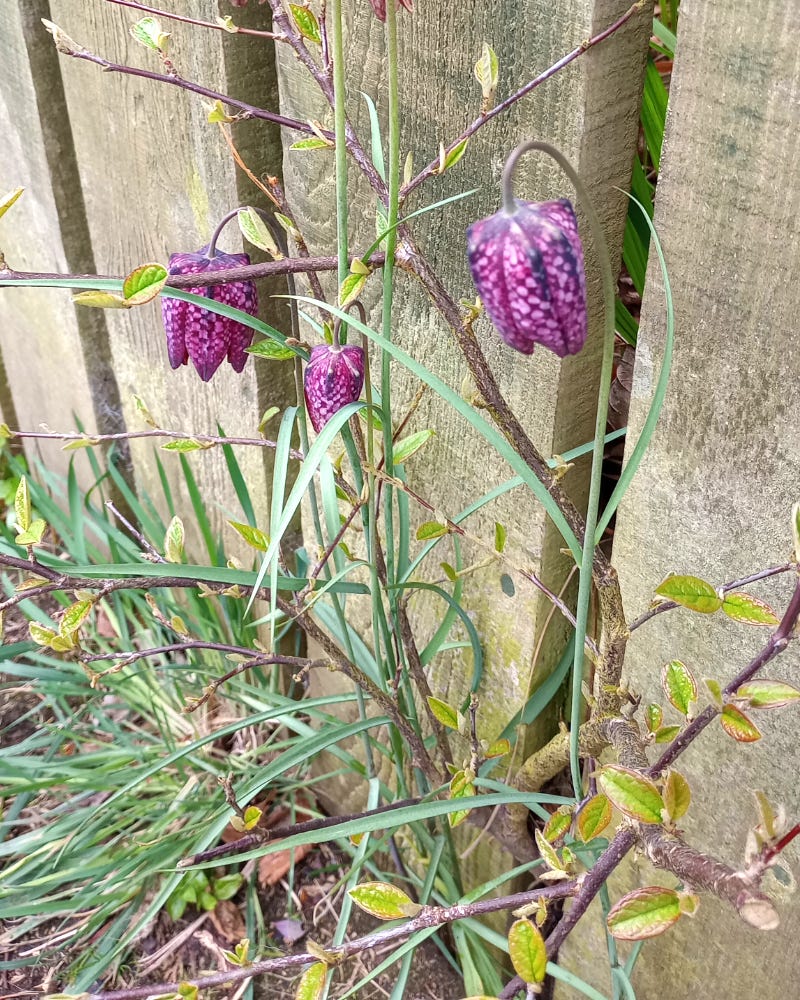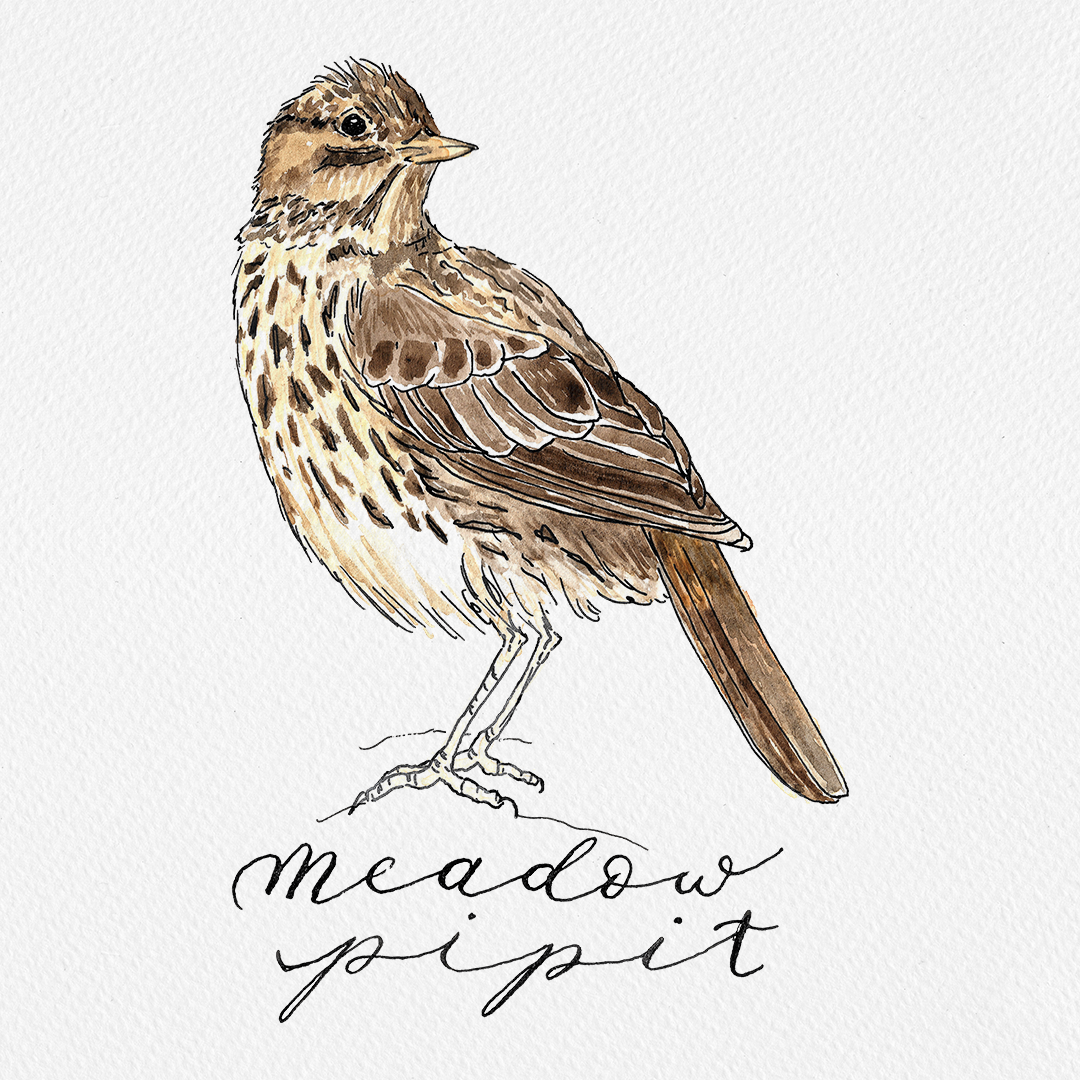April Nature Diary (2025)
Invasive onions, improbable fritillaries, sunshine flowers, and the joy of apple blossom
1st April
Everywhere I go on my morning walks with the dog, seems to have been colonised by Few-Flowered Garlic.
I use the term ‘colonised’ with intention - Few-Flowered Garlic (allium paradoxum - also sometimes known as Few-Flowered Leek) is an invasive wild onion from Asia, introduced to the British Isles in the early 1800s as a garden plant, but it has since escaped into the wild where it grows well in deciduous woodland habitats, forming a green carpet that can smother native plants. You'll also find it along river banks, field edges, roadsides, in hedgerows and on waste ground.
In its favour, the leaves, flowers, bulbs and bulbils (the weird little clusters of ovoids that develop just beneath the flowers) are all edible and, in fact, by pulling these plants up by the roots you'll be doing native species a favour. Few-Flowered Garlic has a more subtle smell and flavour than our native Wild Garlic or Ramsons (allium ursinum) and can be used in similar ways - eg to make a pesto, or a herb butter.
As ever, if you are going to forage, make sure that you’re very certain of what you’re harvesting. Never eat any wild food without multiple sources of positive identification!
Every month I curate a nature diary-style collection of my illustrations and observations of things I’ve noticed and been inspired by in my local environment. Make sure you never miss a post by subscribing to Drawn to Nature for free; and if you are minded to support my work, I’d be grateful if you would consider becoming a paid subscriber.
7th April
Nature has so much to share with us about perseverance, patience and adaptability. Perseverance - the art of doing something difficult, or that takes time to achieve success. Patience - the ability to endure these difficulties and delays without a negative response. Adaptability - being able to adjust and change, especially in response to changing circumstances.
That's why I love it when I notice something growing somewhere unexpected, like these beautiful Snakeshead Fritillaries growing up in the shelter of a fence, having found some sort of home in the cracks at the edge of a tarmac path. What makes this an even more beautiful sight is that Snakeshead Fritillaries are classified as Vulnerable and are on the Vascular Plant Red Data List, thanks to the decline in their traditional wet meadow habitats.
80% of the UK's snakeshead fritillaries now exist in one single place in Wiltshire - North Meadow in Cricklade - where you can see an incredible pink carpet of these flowers every April. Definitely sounds worth a visit!
12th April
Nothing gladdens the heart like a bright yellow flower and when the sun shines they often seem to glow even brighter.
My attention was caught today by two such sights: Lesser Celandine along a wooded path and large patches of the friendly dandelion in a nearby field.
Lesser celandine is a member of the buttercup family that can be found in woodland, grassland and gardens from January to April. As one of the earliest flowers to appear after winter, they're an essential nectar source for pollinators and other insects.
By contrast, you probably think of Dandelions as the quintessential weed - I know my father waged an endless war on dandelions appearing in his lawn - but whatever you do, put away the weed killer! Not only are they lovely flowers to look at, much like the lesser celandine, they’re a valuable food source for a wide variety of pollinators, including bees, butterflies, and hoverflies, particularly in early spring when other flowering plants are scarce.
My friend Jo Thomas 🌿 over on her
Substack has also shared some wonderful recipes for dandelions, if you need even more of a reason to search some out/leave them alone to grow!27th April
The two apple trees we planted in our kitchen garden area five years ago are starting to really come into their own now and this month they’ve been absolutely laden with blossom. We have one culinary apple - White Melrose - which was first grown at Melrose Abbey in the Scottish Borders, possibly from as early as 1600, alongside an eating variety - Sunset - adapted for northern gardens from Cox's Orange Pippin in the early 20th century. They’re both espaliered (where the branches are trained along wires, for heavier cropping) although more recently we’ve planted some untrained apple trees in our mini orchard/wildflower meadow, along with a crab apple and a plum, sweet cherry and pear, to complete the set.
The White Melrose blossom is almost completely white, whilst Sunset has a beautiful deep pink blush to the buds and parts of the flower. They both smell heavenly - and completely different - and we’ve been really enjoying spending time in the garden in the late afternoon/early evening as that is when the fragrance seems to be at its peak.
If you don’t have an apple tree in your garden, I strongly encourage you to get at least one, if not two! There are many pot-grown varieties now that are self-fertile (meaning that they don’t require a different tree to cross-pollinate) as well as grafted onto dwarfing rootstock, ensuring that you can keep the trees to an appropriate size, even if you only have a balcony or small courtyard. The payoff in terms of beautiful-smelling blossom and then delicious apples, picked straight from the tree - is definitely worth it.
New birds for April
My trusty Merlin Bird App has been working overtime this month, helping me to get more familiar with the calls and songs of different birds during my daily dog walks.
This month I’ve been lucky enough to both hear and see two summer visitors to the UK: the Grasshopper Warbler and the House Martin.
The Grasshopper Warbler visits from north-west Africa from April to October. I heard it before I saw it, as it has an incredibly distinctive call similar to the grasshopper from which it gets its name (but much louder) and I eventually located the bird perched amongst some long grass.
Grasshopper Warblers are on the red list for conservation status in the UK, so it was a real treat to identify one and I’ve since seen two of these birds in the same location in the last week.
House Martins also visit from Africa - arriving from as early as March to spend the summer here in the UK. Again, they’re on the red list for conservation status - it is believed that the decline in their numbers is at least partly due to the proliferation of PVC eaves, which the Martin’s mud nests don’t adhere well to.
I’ve also seen quite a few Meadow Pipit this month, both here in North Northumberland as well as on a day trip up to North Berwick in East Lothian during the Easter holidays. They’re native birds and were once common across grasslands, uplands and salt marshes, but populations have been steadily declining since the mid-1970s and they’re now on the amber list for conservation status.
How has your April been? What things have you noticed in nature this month?












I've also been using the Merlin app loads this month! Mostly to double check what(who) I already recognise but doubt I know 😅
Lovely post Ali, thankyou!
It seems like everything has suddenly burst into bloom this week - all the flowering trees and I love watching the trees gain their color - some peaches and yellows deepening into various shades of green. I love watching the changes at this time of year here in New England. I don't know much about birds but I love listening to the dawn chorus in the mornings.